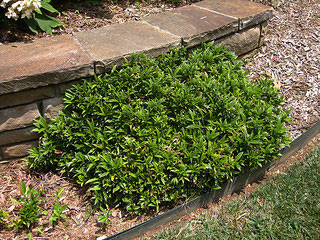Resource Library
Plant of the Week: Sweetbox
Sarcococca is a compact, slowly spreading groundcover or dwarf hedge plant that grows well in shady gardens. (Image courtesy Gerald Klingaman)
Sweetbox
Latin: Sarcococca hookeriana var. humilis
Winter greenery is much celebrated in the garden but sometimes we get stuck in a rut and only choose from a short list of select plants. There are other choices but it may take some looking to find them. One worth seeking out is the dwarfish evergreen shrub called Sarcococca or sweetbox, Sarcococca hookeriana var. humilis.
About 14 species of Sarcococca are described with them ranging throughout Southeast Asia, primarily in the Himalayan Mountains. This species is found from Afghanistan to India and southwestern China with the variety only found in the mountainous region of southwestern China where E.H. Wilson collected it in 1907. They belong to the boxwood family.
While the species grows as a 6-to 8-foot tall rounded, evergreen shrub the variety humilis (which means low growing) grows as an 18-inch tall stoloniferous shrub that slowly spreads to 3- to 4-feet wide. It has deep green, 3-inch long elliptical leaves that are to two-thirds of an inch wide. Unlike boxwoods, the leaves are alternately arranged on branches that grow erect but with a graceful arch. The foliage is said to be deer-proof.
In late winter small but fragrant, not especially showy white, tinged-pink flowers are produced amongst the foliage in the leaf axils. The fruit are blueberry-sized blue-black berries that hide amongst the foliage. The Latin name comes from Greek sarx (flesh - the same root is used in sarcophagus) plus kokkos, which means berry. The species epithet commemorates Joseph Hooker (1817-1911) who collected plants in the Himalayas and was later director of Kew Gardens in London.
Sarcococca are not common in American gardens though they have much to recommend them. They are very drought tolerant and hold up nicely in dry shade. Most species can be grown from zone 6 through zone 8, making them well adapted throughout Arkansas. The compact, stoloniferous form of variety humilis makes it ideally suited for use as a groundcover or an informal hedge in the shade garden. Fragrant Valley™, a more compact spreading form, and Fragrant Mountain™, a more erect but still dwarf form growing about 30 inches tall, are new patented hybrid releases from Sidhu and Sons Nursery in Canada.
These evergreens are best grown in loose, well-drained soils in part shade to heavy shade. Direct sun, especially in the afternoon, will discolor the foliage. They are good additions to the shade garden and can be used near patios or outdoor walkways where the wintertime fragrance can be enjoyed. Sarcococca are easy to propagate by wintertime cuttings or, on established plants, clumps can be dug from the base of the plant.
By: Gerald Klingaman, retired
Retired Extension Horticulturist - Ornamentals
Extension News - January 31, 2014
